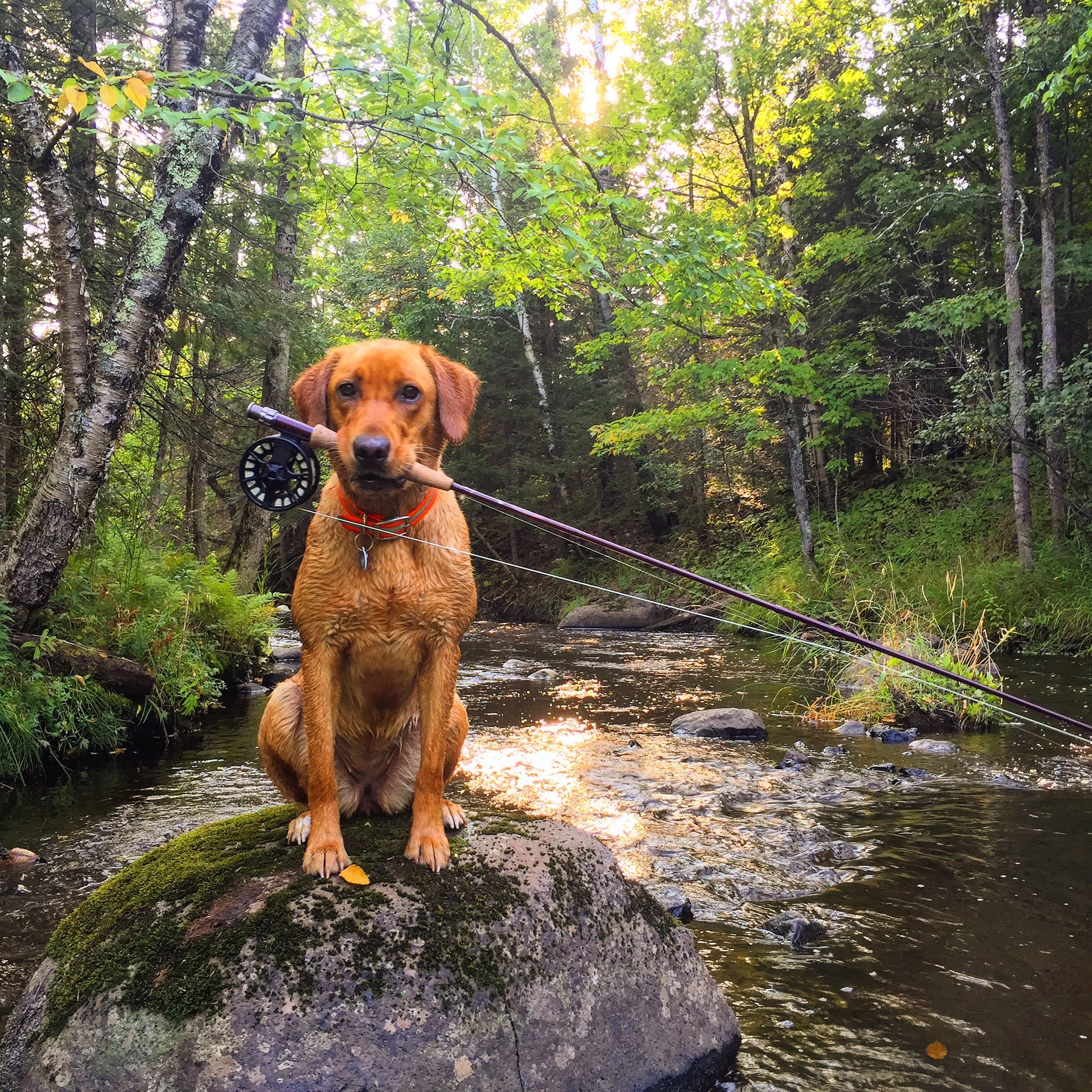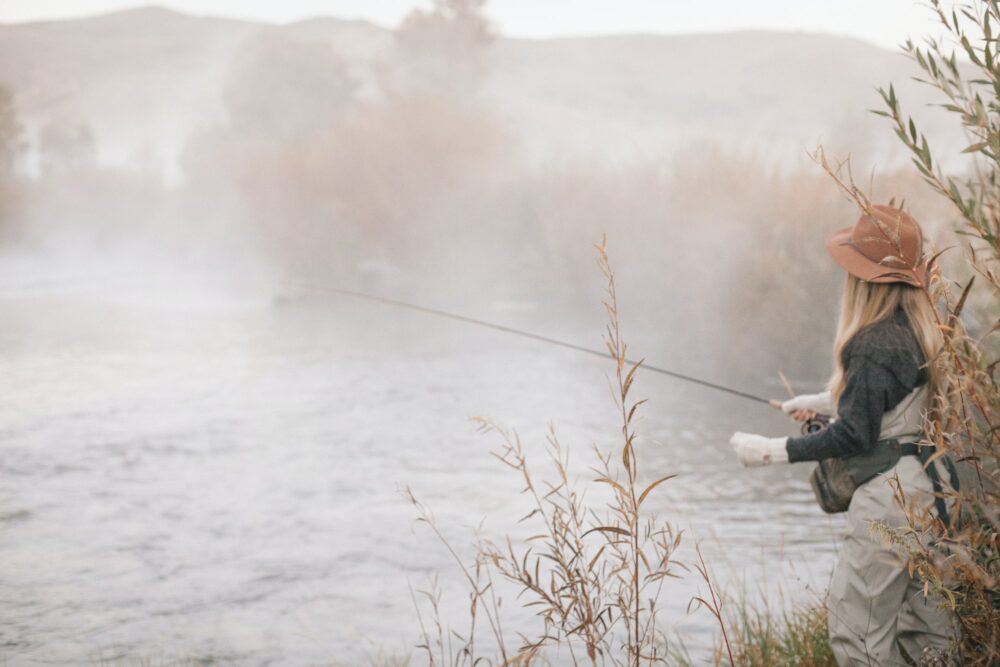
Fall colors and hooking leaves.
Ten Tips for Fall Fishing
By Steve Hudson
Have I introduced you to my buddy Ellie? She’s the resident pup, a 20-pound bundle of sunshine and light with gray hair and brown eyes and a tail that never stops wagging. She’s always happy. But the last few days, she’s been even happier than usual – exuberant, you might say, jumping in circles chasing leaves or hopping across the yard like a little gray deer.
Could it be there’s something in the air right now that makes life better?
You bet there is. It’s fall!
For a lot of fly fishers, fall is the best time of the year. It’s cooler. Streamflows are usually good but not outrageous. Fish are agreeable. It’s fun!
But fall got its name legitimately. It’s the time of year when all those leaves on all those trees start to – well, they start to fall. A lot of them end up in streams.
And that poses a challenge for flyfishers far and wide.
“Another one!” my friend Jack called.
“Trout?” I replied.
“Nope,” said Jack. “Another leaf!”
Jack was fishing a run about 75 feet upstream from me, working a little Pheasant Tail nymph through the deep spots. He had picked up a trout or two along the way, but he had also picked up leaves – a lot of leaves.
“Well,” he mused, “they do call it leaf season!”
Yes, fall fly fishing brings challenges. Not only are those leaves everywhere (that’s a challenge in itself), but the whole ecosystem is changing as fall moves into winter. Your tactics should change, too, and these ten (plus one) tips will help put your fall trips on the road to success.
Make your fly stand out
With all those leaves in the water, you’ll need to make your fly stand out. The easiest way to do that is to give it some motion. One great way to do so is with a streamer. Work the fly so that it moves against or across the flow – or even upstream. The idea is to work the fly in some way that distinguishes it from all those drifting leaves. Another technique that works with nymphs and emergers gives them some motion by letting them hang in the current at the end of the drift or even by working them across the current with small jerks. Use these techniques to make your fly noticeable, and you might draw more strikes.
Tie on a streamer…
Fallfish are often aggressive fish. Whether it’s because they’re preparing to spawn or because they’re competing for meals to bulk up for winter, they’ll waste no time chasing down a minnow – or a streamer. Always carry some streamers in your fall fly box, choosing patterns appropriate for the water you’ll be fishing. Unsure of what to use? Try something bright and/or eye-catching. One of my favorites for fall is the classic Muddler Minnow, especially if it has a little orange or yellow in it. A yellow and brown Clouser-style minnow works well too.

If you have delayed harvest in your state, try this Steve Hudson DH special.
…or a big terrestrial…
Terrestrial insects will be active on most streams until the first good frost knocks them back. Big fish love to grab those late-season hoppers, bees, and beetles, all of which provide a meal with a high energy return. Try a hopper or a big Chernobyl Ant drifted on clear water near edges or along current seams. A small Deer Hair Beetle can work well too. I’ve also had good luck with small panfish poppers, even on trout streams.
…or an ant
Winged ants move around a lot in the fall, and inevitably good numbers of them fall into the water. Trout go for those ants with gusto. Try a dry or drowning ant (or an ant-like attractor like a Royal Coachman) on your next fall outing to see if your local trout like ants as much as mine do.
Downsize your flies
Even if you don’t go with an ant per se, think about downsizing your flies as you move through fall. Insects tend to be smaller as the weather gets cooler. If (for example) you were using a size 12 or 14 during summer, try the same pattern in a size 16 or even 10 during fall. Many fly fishers go with darker-toned flies for fall, too.
Think “stealth”
Even though there may be lots of leaves on the water, don’t forget that fall flows are usually exceptionally clear. That means that wary trout will spot you in a heartbeat if you give them half a chance. To shift the odds in your favor, wear camo. For example, a long-sleeve camo T-shirt or sweatshirt will add a bit of warmth while reducing your visibility to fish too. So will a camo hat. One of the most serious fall anglers I know goes so far as to dab on some camo face paint. I don’t take it quite that far, but then he usually outfishes me, so maybe I should!

A fly fisherman and his dog – have I introduced you to my buddy Ellie?
Low and slow…
Remember that anything you can do to minimize your visual profile will be helpful during the clearwater days of fall along those same lines. That means that a slow, deliberate approach will be less likely to alert fish – especially if you also hunch down or even crawl as you approach prime water. If you’re like me, your knees may draw the line at crawling upon a pool. But you can still up the odds by keeping as low a profile as possible.
…and long!
Because the water is usually so clear during the fall season, a long leader will help to keep you from spooking wary and overly-cautious fish. I like to go one tippet size finer, on average, during the fall. I’ll often go with a longer leader, too, using a 9- or 10-footer where I might have used a 7.5 footer during the summer. Fluorocarbon leaders or tippet material reduces visibility, also, and can be a plus during fall.
Take along a change of clothes
Sometimes, when you wade, you’ll take a spill. During the summer, that can be refreshing. But in the cooler months of fall, a dunking in a cold stream can quickly become a serious problem. Hypothermia is a real risk if you get wet. Should that happen, it’s great to have dry clothes back in the truck. A quick change of wardrobe will keep you warm and get you back to fishing in no time.
Enjoy that extra cup of coffee
Fish and the things that fish eat are coldblooded. They won’t become active until the fall water warms a little. For that reason, dawn fishing usually won’t be too successful on a cool, crisp fall morning. If you’re unsure when to start, check the stream temperature with a small stream thermometer. If the water’s in the 40s or colder, odds are that there’s not a lot going on. Acknowledge that fact and enjoy that extra cup of coffee (or an extra hour of sleep). If the fish don’t get going till 10 a.m., why should you?
Bonus tip: Embrace the leaves!
An undeniable fact of fall fishing is that you, like my buddy Jack, will catch a lot of leaves. That’s a given. Sure, it starts to bug you a little after a while. But short of tying all of your trout flies with tiny little weed guards, what’s an angler to do?
There’s nothing you can do. Leaves happen in the fall. When you do hook one (or another one…or another one!), don’t let it get you down. Just unhook ‘em, throw ‘em back, and cast again. Maybe the next one will be a trout!
Check out some of Hudson’s incredible books here . . .






